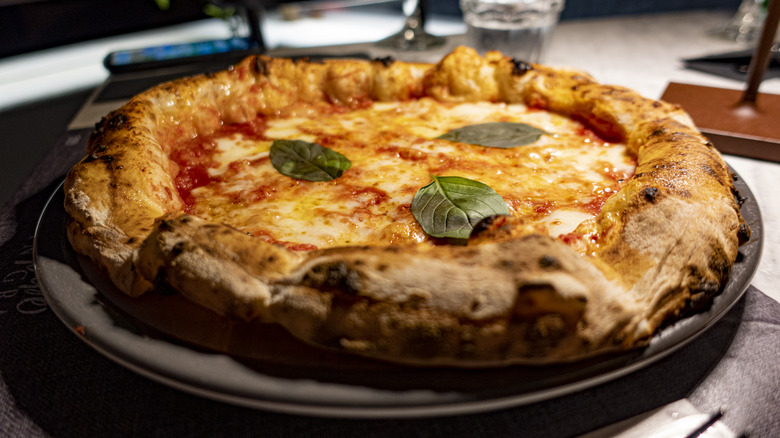The Delicious Neapolitan Pizza That Embarrassed Nancy Silverton
We may receive a commission on purchases made from links.
Hailed as one of the great culinary innovators of the restaurant industry, author and chef Nancy Silverton has made it her mission to articulate the authenticity and soul of Italian cooking in American cuisine. Inspired by the food and ingredients of Tuscany, Silverton initially opened the first La Brea Bakery in 1989 in Los Angeles. Known for her artistry and her expertise — especially with bread — Silverton has since gained prominence in the U.S. since those early La Brea Bakery days (via Los Angeles Magazine). Upon opening Pizzeria Mozza, Silverton translated her expertise in rustic baking to revolutionize California-style pizza by introducing both local Californian produce and authentic imported Italian ingredients. Her pizza can be described as a contemporary take on the traditional Italian pizza, utilizing a woodfired oven and expansive knowledge of bread to make a crust that's fluffy, chewy, with just enough crisp, according to Foodiamo.
When Silverton sought to simply make a really good pizza, she wound up starting Osteria Mozza, whose pies have, according to Silverton's partner and co-chef at Mozza Matt Molina, a unique crust more Roman-inspired than Neapolitan (via Eater). In fact, Silverton previously expressed to Food and Wine writer Jonathan Gold in 2014 that this choice was somewhat intentional. "Neapolitan pizza isn't my style," Silverton admitted, adding, "I've never had pizza in Naples that I've liked." But after one trip to Naples, during which she visited the towns and farms of the region, she discovered a Neapolitan pizza that would shatter her prior opinion of the classic Italian staple.
Nancy Silverton says Franco Pepe's pizza is a slice above the rest
On her trip, Nancy Silverton found tucked away in the rolling hills of Campania, northeast of Naples, in the city of Caiazzo, Italy, a Neapolitan pizza that would make her eat her words with a slice of what has been deemed the best pizza in the world. Born into a family of pizza smiths, Chef Franco Pepe's reinterpretations of traditional Neapolitan-style pizzas like the Margherita have earned him the acclaim of great culinary influencers, including Silverton herself (via Food and Wine).
As recounted in a 2022 episode of "Chef's Table: Pizza" about Pepe — who learned pizza making from his father as a child, worked in his family's pizzeria, then years later opened up his own, Pepe in Grani, in 2012 — Pepe's dedication to his ingredients is apparent (via FoodSided). The chef sources virtually all of his ingredients from local suppliers, mixes all his dough by hand, and refuses to have any machinery in his kitchen, aside from a thermometer.
As a fellow pizzaiolo, Silverton praised Pepe's obsession and mastery over his craft while speaking with Food and Wine in 2014, whose opinion on the craft of pizza-making apparently changed drastically after trying Pepe's Neapolitan pie for the first time. "It feels almost as if Franco [Pepe] invented pizza and everyone else is just copying him," said Silverton. "His is probably the best pizza in the world."
The stylistic differences of pizza
Franco Pepe makes his pizza in a traditional Neapolitan style — and while Nancy Silverton is known for an aesthetically similar, albeit rustic, Roman style, both methods have their subtle differences. The key difference in pizza styles is defined by the role (and sometimes roll) of the crust. A traditional Neapolitan-style pizza will be light, tender, and a bit spongey, to soak the sauce into the bread, according to the Pizza University and Culinary Arts Center, as the role of a Neapolitan crust is more center stage, and the sauce and toppings complement the flatbread.
In contrast to the purist nature of Neapolitan pizza, Roman-style pizza is thinner and crispier, with more topping variety, according to MasterClass. Silverton's pizza reflects this preference for Roman style while drawing inspiration across pizza genres. Her crust is a genre-defying curation of flours, malts, and yeast that has the crispy, chewy aspects of a Roman style adorned with locally inspired topping combinations, with a rustic charred aesthetic of Neapolitan style, to create something that's uniquely, deliciously her own (via The New York Times).
Pepe's pizza represents the pursuit of excellence within the Neapolitan genre, and his artful arrangements of homeland flavors on masterfully crafted crusts have caused many to rethink their position on pizza style preferences, as discussed in Pepe's episode of Netflix's "Chef's Table: Pizza." As pizza chefs Like Pepe and Silverton continue to push culinary boundaries, even hardline pizza-style loyalists are finding it difficult to put pizza in just one box.


